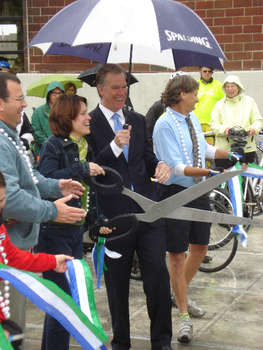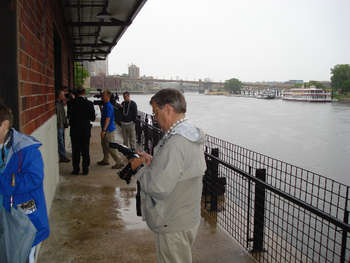Head House and Sack House Re-Opens to the Public in St. Paul

MNRRA Superintendent Paul Labovitz, Congresswoman Betty McCollum, and St. Paul Mayor Chris Coleman cut the ribbon to open the newly-designated trail at the St. Paul Headhouse on June 6th.
Photo: Andrew Hine
by Bob Spaulding
The much anticipated public re-opening of the historic Head House and Sack House, commonly referred to as, simply, "City House", took place earlier this month. The City of St. Paul Housing and Redevelopment Authority spent more than $2 million renovating the former grain terminal. It will now host public and private gatherings and serve as a picnic area and rest stop along the 3,000-mile-long Mississippi River Trail.
The grand opening included guided bike tours by National Park rangers and was celebrated by local dignitaries and citizens alike.
The Head House and Sack House were once part of a large building complex which served as the grain terminal for the Equity Cooperative Exchange, a farmer's cooperative formed in 1911 to counter the control merchants had over grain prices and provide an alternative market.
FMR board member and National Park Historian John Anfinson explained why the preserving the two buildings was so important.
"Minneapolis has the A Mill, the Mill City Museum and Mill Ruins Park all celebrating its history as an early port city, but in St. Paul the Head House and Sack House are the last vestiges of St. Paul's history as a working port as the head of navigation on the Mississippi, and so it was very critical that we preserve that," Anfinson said. "It's also symbolic of the restoration of commerce on the Mississippi and the beginning of the farm cooperative movement in America."

The new Headhouse overlooks the Mississippi River.
Photo: Andrew Hine
From Dr. John Anfinson, historian and superintendent of the National Park Serivce Mississippi National River & Recreation Area:
"The Equity Cooperative Exchange was formed by farmers in 1911 to provide an alternative to the Minneapolis market. The Equity built grain elevators on the Upper Levee in 1915. But low river levels and cheap grain shipping through the new Panama Canal made Mississippi River traffic almost disappear. Farmers fought back pushing for improved navigation in the river. The Minnesota Farmers Union took over the Equity Cooperative and pushed hard for the government to dredge and maintain a 9-foot-deep navigation channel to allow reliable grain shipment out of the Midwest. The Farmers Union, under George Lambert, expanded the elevators on the Upper Levee in 1927-31, and persuaded Congress to fund the 9-foot channel in 1930. The complex eventually included 90 grain silos, a mill, the tall head house for loading grain onto barges, and the sack house where grain was put into bags."